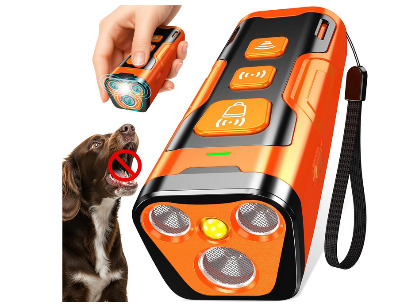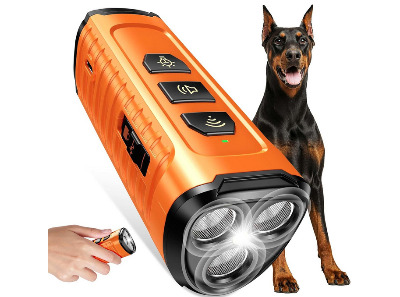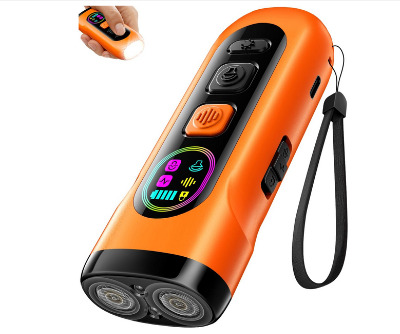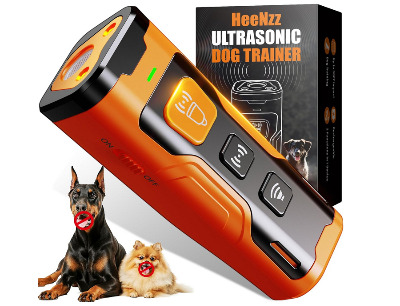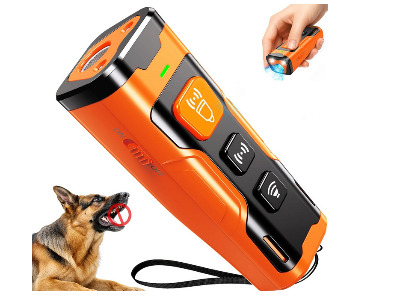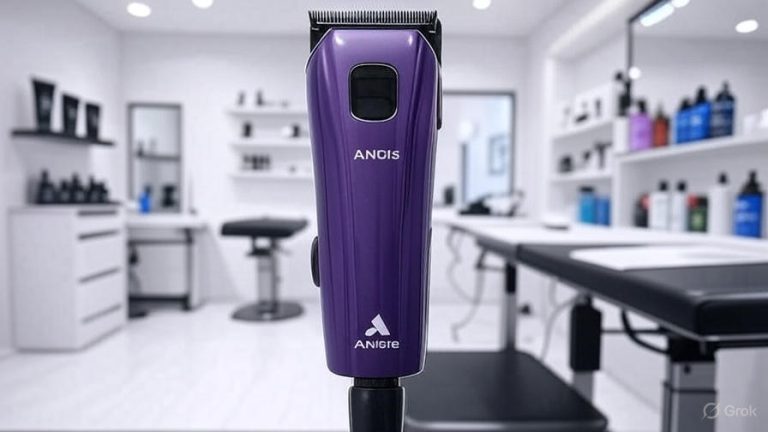5 Best Bark Deterrent for Dogs In 2025
Excessive barking can turn your peaceful home into a noisy battleground. You’ve tried everything from training treats to verbal commands, but your furry friend continues to bark at every passing car, doorbell ring, or neighbor’s dog. The good news is that modern bark deterrent devices offer a humane and effective solution to this common problem.
This comprehensive guide examines the top bark control devices available today. These ultrasonic trainers use high-frequency sound waves that dogs can hear but humans cannot. They provide a safe, pain-free method to discourage unwanted barking behavior in your own pet or even your neighbor’s dog.
Understanding How Ultrasonic Bark Deterrents Work
Ultrasonic bark deterrents emit a high-pitched sound when activated. Dogs possess hearing capabilities far superior to humans, detecting frequencies up to 65,000 Hz while humans max out around 20,000 Hz. When a dog barks, the device releases this ultrasonic tone, which startles the animal without causing physical harm.
The sound acts as a distraction and negative association with barking behavior. Over time, dogs learn to connect their excessive vocalization with the unpleasant sound. This conditioning helps reduce barking frequency naturally. The technology works on the same principle as professional dog training whistles but with automated functionality.
Most modern devices come with adjustable sensitivity levels and multiple training modes. These features allow you to customize the deterrent based on your dog’s size, temperament, and specific barking triggers. Some models include manual buttons for targeted training sessions, while others activate automatically when they detect barking sounds.
Top 5 Bark Deterrent Devices Reviewed
1. YUYQA Dog Bark Deterrent Device – Best Overall Performance
The YUYQA bark deterrent stands out as a top contender in the anti-barking device market. This compact unit delivers triple ultrasonic power, making it three times more effective than standard single-speaker models. The device reaches up to 23 feet, covering most residential yards and indoor spaces with ease.
Product Description:
This rechargeable bark control device features six distinct training modes, giving you flexibility in addressing various barking situations. The device weighs less than a smartphone, making it incredibly portable for walks, training sessions, or travel. Its ergonomic design fits comfortably in your hand, and the intuitive button layout requires no complicated setup.
The YUYQA model uses intelligent bark recognition technology. It can distinguish between normal canine communication and excessive, problematic barking. This smart feature prevents over-correction and helps maintain your dog’s natural ability to communicate when necessary.
Key Features:
- Triple ultrasonic emitters for enhanced effectiveness
- Six adjustable training modes
- 23-foot effective range
- Rechargeable battery with USB charging
- Compact, pocket-sized design
- Weatherproof construction for outdoor use
- LED indicator lights
- Intelligent bark recognition system
Pros:
- Powerful triple ultrasonic technology works faster than single-speaker models
- Rechargeable battery eliminates the need for constant battery replacements
- Compact size makes it easy to carry during walks or outdoor activities
- Six modes provide versatility for different training scenarios
- Works effectively on stubborn barkers
- Durable construction withstands outdoor conditions
- Easy to operate with simple button controls
- Effective for both small and large breed dogs
Cons:
- 23-foot range may be limiting for large properties
- Some extremely stubborn dogs may require longer training periods
- LED lights could be brighter for low-light visibility
- May need frequent charging with daily intensive use
Best For:
This device excels for pet owners dealing with persistent barking issues in medium-sized yards or indoor environments. It’s particularly effective for training multiple dogs simultaneously, thanks to its triple ultrasonic output. The six training modes make it ideal for addressing different types of barking behavior, from excitement barking to territorial alerts.
2. Cbersmg Anti Barking Device – Best Long-Range Option
The Cbersmg device redefines what’s possible in bark control technology. With an impressive 50-foot range, this unit covers larger areas than most competitors. It serves dual purposes as both a bark deterrent and a training tool, complete with an integrated flashlight for nighttime use.
Product Description:
This advanced bark control system employs five distinct modes tailored to different training needs. The extended range makes it particularly valuable for those dealing with neighbor’s dogs or working in spacious outdoor areas. The built-in flashlight adds practical value during evening walks or when training in dimly lit conditions.
The Cbersmg device features automatic bark detection that triggers the ultrasonic sound without manual intervention. This hands-free operation proves especially useful when you’re busy with other tasks but still need to maintain bark control. The unit’s sensitivity adjustment allows fine-tuning based on ambient noise levels in your environment.
Key Features:
- 50-foot maximum effective range
- Five training modes for varied situations
- Integrated LED flashlight
- Automatic bark detection system
- Manual trigger button for direct training
- Adjustable sensitivity controls
- Rechargeable lithium battery
- Waterproof housing rated for outdoor use
Pros:
- Extended 50-foot range covers large yards and outdoor spaces effectively
- Built-in flashlight adds practical functionality for nighttime training
- Five modes provide excellent flexibility for different scenarios
- Works well for neighbor’s barking dogs from your property
- Automatic detection allows hands-free operation
- Strong battery life supports extended training sessions
- Suitable for all dog sizes and breeds
- Easy-to-read LED indicators show mode and battery status
Cons:
- Larger size compared to pocket-sized alternatives
- Slightly heavier, which may be noticeable during long walks
- Automatic mode may occasionally trigger from other loud sounds
- Higher price point than basic models
Best For:
The Cbersmg device shines in situations requiring extended range coverage. If you live on a larger property or need to address barking from neighboring dogs, this model delivers the reach you need. The flashlight feature makes it particularly appealing for dog owners who frequently walk their pets during early morning or evening hours.
3. SEDULAN Ultrasonic Bark Stopper – Best Budget-Friendly Choice
The SEDULAN bark stopper proves that effective bark control doesn’t require breaking the bank. This orange-colored device combines affordability with solid performance, reaching up to 50 feet while maintaining a competitive price point. It’s designed for both personal use and addressing neighborhood barking issues.
Product Description:
This portable training tool features a straightforward design that prioritizes functionality over fancy extras. The device uses reliable ultrasonic technology to discourage excessive barking in dogs of all sizes. Its bright orange color makes it easy to spot in your bag or yard, reducing the chances of misplacing it.
The SEDULAN model includes both automatic and manual operation modes. Automatic mode constantly monitors for barking sounds and responds accordingly, while manual mode gives you direct control for targeted training exercises. This dual functionality makes it versatile enough for various training approaches.
Key Features:
- 50-foot operational range
- Dual automatic and manual modes
- Portable, lightweight construction
- High-visibility orange design
- Weather-resistant casing
- Simple two-button operation
- Battery-powered with low consumption
- Safety wrist strap included
Pros:
- Affordable price makes it accessible for budget-conscious pet owners
- 50-foot range matches more expensive competitors
- Simple operation requires minimal learning curve
- Lightweight design won’t weigh you down during walks
- Bright color prevents accidental loss
- Effective on most dogs regardless of breed
- Battery-powered means no waiting for recharges
- Compact enough to fit in most pockets or bags
Cons:
- Lacks the multiple mode options found in premium models
- Battery replacement needed periodically
- Basic design without advanced features
- No built-in flashlight or additional tools
- Plastic construction feels less premium than metal alternatives
Best For:
This bark deterrent suits dog owners looking for a reliable, no-frills solution to barking problems. It’s an excellent first bark control device for those testing the waters with ultrasonic training. The combination of effective range and budget-friendly pricing makes it accessible for renters dealing with barking issues in apartment complexes or townhome communities.
4. HeeNzz Ultrasonic Dog Training Device – Best for Neighbor’s Dogs
The HeeNzz device specializes in handling barking problems beyond your property line. This model emphasizes safety and effectiveness for addressing noise issues from neighboring properties. Its discreet operation allows you to discourage barking without creating conflict with nearby pet owners.
Product Description:
HeeNzz designed this bark deterrent with versatility in mind. It functions equally well for training your own dogs or addressing external barking disturbances. The device features an optimized ultrasonic frequency specifically calibrated to penetrate through common barriers like fences and hedges without losing effectiveness.
The unit includes an automatic activation system with smart sound recognition. This technology helps filter out non-barking sounds like traffic noise or children playing, focusing specifically on canine vocalizations. The result is more targeted and effective bark control without constant false triggers.
Key Features:
- Ultrasonic technology safe for all dog breeds
- Indoor and outdoor operational capability
- Smart sound recognition filters
- Automatic activation with manual override
- Effective through common barriers
- Durable ABS plastic construction
- Orange safety color for high visibility
- Hanging hook for stationary placement
Pros:
- Specifically optimized for addressing neighbor’s dogs
- Smart filters reduce false activations from environmental noise
- Safe ultrasonic frequency won’t harm animals
- Can be mounted or carried for flexible use
- Works through fences and other barriers effectively
- Simple setup requires no technical expertise
- Reliable automatic operation for constant control
- Suitable for various dog temperaments and sizes
Cons:
- Range specifications less clearly defined than competitors
- May require optimal positioning for best results with neighbor’s dogs
- Automatic mode battery consumption higher than manual-only devices
- Orange color, while safe, may not suit all aesthetic preferences
Best For:
The HeeNzz device excels when dealing with barking dogs from adjacent properties. If your neighbor’s pets regularly disturb your peace, this unit provides a diplomatic solution that doesn’t require confrontation. The smart recognition technology also makes it valuable for multi-dog households where you need to discourage excessive barking without interfering with normal canine communication.
5. QVNNVQ Anti Barking Device – Best All-Purpose Solution
The QVNNVQ bark deterrent rounds out our top five with a balanced approach to bark control. This orange-colored device delivers consistent performance across various situations, making it a reliable all-purpose choice. It handles both indoor and outdoor environments with equal effectiveness.
Product Description:
QVNNVQ built this device to be a complete bark control solution. It works effectively on your own dogs during training sessions and can address barking from neighborhood pets. The device uses proven ultrasonic technology combined with user-friendly controls that anyone can master quickly.
The unit features a tested frequency range that affects dogs without impacting cats, humans, or other animals. This selective targeting ensures you’re only addressing canine behavior without creating unintended disturbances. The device’s moderate size strikes a balance between portability and effective speaker output.
Key Features:
- Ultrasonic bark deterrent technology
- Dual-purpose design for own and neighbor’s dogs
- Indoor and outdoor functionality
- Safety-tested frequency range
- Portable handheld design
- Weather-resistant construction
- Simple operation with minimal buttons
- Visible orange safety color
Pros:
- Versatile enough for multiple bark control scenarios
- Safe frequency affects only dogs, not other pets or people
- Works effectively in both confined indoor spaces and open outdoor areas
- Straightforward operation suitable for all users
- Portable size convenient for travel or walks
- Durable construction withstands regular use
- Effective range covers typical residential needs
- Reasonable price point for the features offered
Cons:
- Fewer training modes compared to premium models
- Battery life adequate but not exceptional
- Range specifications could be more detailed
- Basic feature set without bonus functions like flashlights
Best For:
This bark deterrent serves dog owners seeking a dependable, straightforward solution without overwhelming options. It’s particularly suitable for those who split their time between indoor and outdoor environments, needing a single device that performs well in both settings. The balanced feature set makes it an excellent choice for first-time users of ultrasonic bark control technology.
Key Factors to Consider When Buying a Bark Deterrent
Effective Range Requirements
Range determines how far the ultrasonic waves travel before losing effectiveness. Small apartments or indoor use typically requires only 15-20 feet of range. Larger homes with multiple rooms need devices reaching 30-40 feet. Outdoor applications, especially for addressing neighbor’s dogs, benefit from 50-foot ranges or more.
Consider your specific environment before purchasing. Walls, furniture, and other obstacles can reduce effective range. If you primarily plan indoor use, a shorter-range device often suffices and may save money. Outdoor scenarios involving large yards or addressing barking across property lines demand maximum range capabilities.
Training Modes and Flexibility
Multiple training modes provide options for different situations. Some dogs respond immediately to standard ultrasonic frequencies, while others require varied approaches. Devices with 3-6 modes let you experiment to find what works best for your specific dog.
Look for models offering both automatic and manual modes. Automatic operation handles constant monitoring when you’re busy. Manual mode gives you precise control during focused training sessions. This combination delivers the flexibility needed for comprehensive bark training programs.
Power Source Considerations
Rechargeable devices offer convenience and long-term cost savings. They typically use USB charging, making them easy to power up anywhere. Battery life varies widely, from a few hours to several days per charge. Consider your usage patterns when evaluating battery specifications.
Standard battery-powered units provide consistent power without recharge waiting periods. They work well if you forget to charge devices regularly. However, ongoing battery replacement costs add up over time. Calculate long-term expenses when comparing power options.
Build Quality and Durability
Outdoor use demands weatherproof construction. Look for devices rated as water-resistant or waterproof if you’ll use them in yards or during walks in various weather conditions. Indoor-only devices can use lighter construction but should still withstand occasional drops.
Material quality affects longevity. ABS plastic offers good durability at reasonable costs. Metal housings provide premium feel and enhanced protection. Check user reviews for real-world durability reports beyond manufacturer specifications.
Size and Portability Needs
Pocket-sized devices excel for walks, training classes, or travel. They slip easily into bags or pockets without adding noticeable weight. Larger units may offer more powerful speakers or extended battery life but sacrifice portability.
Stationary devices designed for mounting in specific locations focus on coverage area over portability. These work well for consistent yard placement or room-specific indoor use. Match size to your primary intended application.
Maximizing Effectiveness of Your Bark Deterrent
Proper Initial Introduction
Start bark deterrent training in a controlled environment with minimal distractions. Let your dog become familiar with the device’s sound at lower sensitivity settings before increasing intensity. This gradual introduction prevents overwhelming your pet and improves training success.
Use the device consistently during early training phases. Dogs learn through repetition and clear associations. Sporadic use confuses the learning process and extends training time. Commit to regular sessions for the first few weeks.
Optimal Placement Strategies
Position stationary devices at dog ear level for maximum effectiveness. Sound waves disperse in cone patterns from the speaker. Central placement in the area you’re protecting provides the most comprehensive coverage.
For neighbor’s dogs, position the device facing their property along shared fence lines. Test different locations to find where the bark deterrent reaches the target area most effectively. Remember that dense vegetation and solid barriers can block or weaken ultrasonic waves.
Combining Methods for Best Results
Bark deterrents work best as part of comprehensive training programs. Combine ultrasonic correction with positive reinforcement when your dog remains quiet. This balanced approach teaches both what not to do and what you want instead.
Address underlying barking causes while using deterrent devices. Dogs bark for reasons including boredom, anxiety, territorial behavior, or alerting. Meeting your dog’s physical exercise needs and mental stimulation requirements reduces excessive vocalization naturally.
Maintenance and Care Tips
Keep device speakers clean and free from debris. Dust and dirt accumulation can muffle ultrasonic output, reducing effectiveness. Wipe devices regularly with dry cloths. Avoid getting internal components wet unless the device carries full waterproof ratings.
Monitor battery levels and recharge before complete depletion. Lithium batteries last longer when maintained between 20-80% charge. Replace standard batteries at the first signs of reduced performance rather than waiting for complete failure.
Test your device periodically to ensure proper function. Some dogs may become desensitized if the ultrasonic output weakens over time. Regular testing catches problems before they affect training results.
Safety Considerations and Humane Use
Understanding Ultrasonic Safety
Ultrasonic bark deterrents are designed as safe, humane training tools. The sound waves cause no physical pain or lasting effects. Dogs may find the noise unpleasant or startling, but it doesn’t damage hearing or cause psychological trauma when used properly.
Research shows ultrasonic frequencies at the levels used by bark deterrents don’t harm canine hearing. The devices emit sounds at volumes and durations well below thresholds that could cause damage. They function similarly to naturally occurring high-frequency sounds in the environment.
Appropriate Use Guidelines
Never use bark deterrents as punishment for normal canine behavior. Dogs bark for legitimate reasons including alerting you to dangers, communicating with other dogs, or expressing excitement. Reserve deterrent use for excessive, problematic barking that disrupts household peace or disturbs neighbors.
Avoid using devices continuously for extended periods. Intermittent use during training proves more effective than constant activation. Dogs can become desensitized to any stimulus applied non-stop. Strategic, targeted use maintains effectiveness and prevents habituation.
Special Considerations for Sensitive Dogs
Young puppies under six months shouldn’t be exposed to ultrasonic bark training. Their developing hearing makes them more sensitive to high-frequency sounds. Wait until dogs reach maturity before introducing deterrent devices.
Senior dogs with hearing loss may not respond to ultrasonic deterrents. Their reduced hearing range might not include the frequencies these devices emit. Similarly, some breeds have inherently different hearing ranges that may affect deterrent effectiveness.
Dogs with anxiety disorders require special consideration. Bark deterrents work by creating negative associations, which could worsen anxiety in some cases. Consult with professional dog trainers or veterinary behaviorists before using deterrents on anxious dogs.
Common Bark Control Challenges and Solutions
Device Not Working Initially
Dogs sometimes ignore bark deterrents during first exposures. This doesn’t mean the device is defective. Some dogs require multiple exposures before connecting the ultrasonic sound with their barking behavior. Continue consistent use for at least two weeks before evaluating effectiveness.
Ensure you’re using appropriate sensitivity and mode settings. Starting too low may produce no response. Too high might trigger constantly, preventing your dog from understanding the connection to barking. Adjust settings based on your dog’s initial reactions.
Neighbor Relations and Bark Control
Addressing neighbor’s barking dogs requires diplomatic approaches. Consider discussing the issue directly before deploying bark deterrents. Many neighbors appreciate knowing about disturbances and will take corrective action themselves.
If direct conversation seems unproductive, bark deterrents offer non-confrontational solutions. Position devices discreetly and use them consistently. Most neighbors won’t even know you’re using sound-based correction. The reduced barking benefits everyone without creating conflicts.
Weather Impact on Outdoor Effectiveness
Rain, wind, and temperature extremes affect ultrasonic wave propagation. Heavy rain can scatter sound waves, reducing effective range. Strong winds may carry sounds away from intended targets. Cold temperatures slightly increase sound transmission, while heat can reduce it marginally.
Adjust device positioning based on weather patterns. During windy conditions, place devices downwind of target areas. In rainy weather, move closer to barking sources or shelter devices under eaves while maintaining line-of-sight to the target area.
Multiple Dog Households
Training multiple dogs simultaneously presents unique challenges. Different dogs may respond to various frequencies and sensitivity levels. Start with middle-range settings that affect most dogs, then fine-tune based on the responses of your most stubborn barker.
Some dogs in multi-dog households bark in response to other dogs. Breaking this chain reaction requires addressing the instigator first. Identify which dog starts barking episodes and focus initial training on that individual.
Long-Term Training Success Strategies
Setting Realistic Expectations
Bark control training doesn’t produce instant results. Most dogs require 2-4 weeks of consistent training before showing significant improvement. Some stubborn or highly excitable breeds may need longer periods. Patience and consistency determine success more than device quality alone.
Complete elimination of barking isn’t a realistic goal. Dogs need to bark for communication and alerts. Aim for reducing excessive, disruptive barking while allowing appropriate vocalization. This balanced approach maintains your dog’s natural behaviors while improving household peace.
Gradual Reduction Approach
As your dog’s barking decreases, gradually reduce deterrent use. This weaning process prevents dependence on the device for bark control. Start by using the device only during problem times rather than continuously. Slowly extend periods without the device present.
Some dogs may test boundaries when deterrents are removed initially. Brief regression is normal and doesn’t indicate training failure. Reintroduce the device temporarily during setback periods, then try removal again after behavior stabilizes.
Alternative Training Methods Integration
Combine bark deterrents with obedience training for comprehensive results. Teaching “quiet” commands gives you verbal control over barking. Reward-based training builds positive associations with silence that complement deterrent-based corrections.
Provide adequate physical exercise and mental stimulation. Tired dogs bark less from boredom or excess energy. Regular walks, play sessions, and puzzle toys address root causes of excessive vocalization beyond what any deterrent device can achieve alone.
Monitoring and Adjusting Your Approach
Track barking incidents in a simple log. Note dates, times, durations, and apparent triggers. This data reveals patterns that help refine your training approach. You might discover your dog barks primarily during certain hours or in response to specific stimuli.
Adjust training strategies based on log data. If barking occurs mainly when you’re away, anxiety might be the root cause requiring different interventions. Pattern recognition leads to more effective solutions than blanket deterrent use.
Environmental and Ethical Considerations
Impact on Other Animals
Most ultrasonic bark deterrents don’t affect cats, birds, or other common pets. The frequencies specifically target canine hearing ranges. However, some small mammals and wildlife may detect these sounds. Use outdoor devices judiciously in areas with sensitive wildlife populations.
Neighbors with multiple pets deserve consideration. While your bark deterrent shouldn’t harm their cats or other animals, it could create minor disturbances. Open communication about your bark control efforts prevents misunderstandings and maintains good relationships.
Noise Pollution Awareness
Ironically, addressing dog barking involves creating additional sound, even if humans can’t hear it. Be mindful of deploying multiple devices simultaneously or using them excessively. The goal is reducing overall noise pollution, not simply shifting it to inaudible frequencies.
Some humans, particularly young children and teenagers, can detect ultrasonic frequencies at the lower end of bark deterrent ranges. If household members report hearing high-pitched sounds, adjust device settings or positioning to minimize their exposure.
Responsible Pet Ownership Practices
Bark deterrents are tools, not replacements for proper pet care and training. Dogs need adequate attention, exercise, socialization, and mental stimulation. Addressing these fundamental needs reduces problem behaviors more effectively than any device.
Regular veterinary checkups ensure medical issues aren’t causing excessive barking. Pain, cognitive decline, or other health problems can manifest as increased vocalization. Rule out medical causes before attributing all barking to behavioral problems.
Making Your Final Decision
The ideal bark deterrent depends on your specific situation. The YUYQA device leads our recommendations for most users with its powerful triple ultrasonic output and six training modes. Its 23-foot range handles typical residential needs while the compact design ensures portability.
For larger properties or addressing neighbor’s dogs, the Cbersmg model’s 50-foot range and integrated flashlight provide superior coverage and versatility. The SEDULAN device offers budget-conscious buyers solid performance without premium pricing. The HeeNzz unit specializes in neighbor situations, while the QVNNVQ provides reliable all-purpose functionality.
Consider your primary use case, budget constraints, and specific features that matter most to your situation. All five devices reviewed here use safe, humane ultrasonic technology proven effective for reducing excessive barking. Success depends more on consistent application than device selection alone.
Start your bark control journey with realistic expectations and commitment to proper use. These modern training tools provide effective solutions to one of pet ownership’s most common challenges. Your path to a quieter, more peaceful home begins with taking that first step toward addressing excessive barking.
Remember that bark deterrents work best as part of comprehensive pet care that includes training, exercise, and attention to your dog’s overall wellbeing. The right device combined with responsible pet ownership creates the foundation for long-term success in managing barking behavior.


